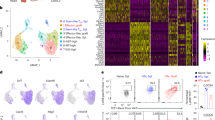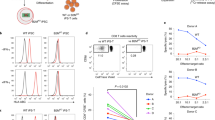Abstract
The CD4+ T-cell pool in HIV-infected patients is in a constant state of flux as CD4+ T cells are infected and destroyed by HIV and new cells take their place. To study T-cell survival, we adoptively transferred peripheral blood lymphocytes transduced with the neomycin phosphotransferase gene between syngeneic twin pairs discordant for HIV infection. A stable fraction of marked CD4+ T cells persisted in the circulation for four to eighteen weeks after transfer in all patients. After this time there was a precipitous decline in marked cells in three of the patients. At approximately six months, marked cells were in lymphoid tissues in proportions comparable to those found in peripheral blood. In two patients, the proportion of total signal for the transgene (found by PCR analysis) in the CD4/CD45RA+ T-cell population relative to the CD4/CD45RO+ population increased in the weeks after cell infusion. These findings indicate that genetically-marked CD4+ T cells persist in vivo for weeks to months and that the CD4+ T-cell pool in adults is maintained mostly by the division of mature T cells rather than by differentiation of prethymic stem cells. Thus, after elements of the T-cell repertoire are lost through HIV infection, they may be difficult to replace.
This is a preview of subscription content, access via your institution
Access options
Subscribe to this journal
Receive 12 print issues and online access
$209.00 per year
only $17.42 per issue
Buy this article
- Purchase on Springer Link
- Instant access to full article PDF
Prices may be subject to local taxes which are calculated during checkout
Similar content being viewed by others
References
Wei, X. et al. Viral dynamics in human immunodeficiency virus type 1 infection. Nature 373, 117–122 (1995).
Ho, D.D. et al. Rapid turnover of plasma virions and CD4 lymphocytes in HIV-1 infection. Nature 373, 123–126 (1995).
Kovacs, J.A. et al. Controlled trial of interleukin-2 infusions in patients infected with the human immunodeficiency virus. N. Engl. J. Med. 335, 1350–1356 (1996).
Coffin, J.M. HIV population dynamics in vivo: Implications for genetic variation, pathogenesis, and therapy. Science 267, 483–489 (1995).
Autran, B. et al. Positive effects of combined antiretroviral therapy on CD4+ T cell homeostasis and function in advanced HIV disease. Science 277, 112–116 (1997).
Pakker, N.G. et al. Biphasic kinetics of peripheral blood T cells after triple combination therapy in HIV-1 infection: A composite of redistribution and proliferation. Nature Med. 4, 208–214 (1998).
Gorochov, G. et al. Perturbation of the CD4+ and CD8+ T-cell repertoires during progression to AIDS and regulation of the CD4+ repertoire during antiviral therapy. Nature Med. 4, 215–221 (1998).
Roederer, M. Getting to the HAART of T cell dynamics. Nature Med. 4, 145–146 (1998).
Connors, M. et al. HIV infection induces changes in CD4+ T-cell phenotype and depletions within the CD4+ T-cell repertoire that are not immediately restored by antiviral or immune-based therapies. Nature Med. 3, 533–540 (1997).
Lederman, M. et al. Abstract LB13. 4th Conference on Retroviruses and Opportunistic Infections, Washington (1997).
Lane, H.C. et al. Syngeneic bone marrow transplantation and adoptive transfer of peripheral blood lymphocytes combined with zidovudine in human immunodeficiency virus (HIV) infection. Ann. Intern. Med. 113, 512–519 (1990).
Pilarski, L.M., Gillitzer, R., Zola, H., Shortman, K. and Scollay, R. Definition of the thymic generative lineage by selective expression of high molecular weight isoforms of CD45 (T200). Eur. J. Immunol. 19, 589–597 (1989).
McLean, A.R. and Michie, C.A. In vivo estimates of division and death rates of human T lymphocytes. Proc Natl. Acad. Sci. USA 92, 3707–3711 (1995).
Sprent, J. Lifespans of naive, memory and effector lymphocytes. Curr. Opin. Immunol. 5, 433–438 (1993).
Bordignon, C. et al. Gene therapy in peripheral blood lymphocytes and bone marrow for ADA−immunodeficient patients. Science 270, 470–475 (1995).
Blaese, R.M. et al. T lymphocyte-directed gene therapy for ADA− SCID: Initial trial results after 4 years. Science 270, 475–479 (1995).
Bonini, C. et al. HSV-TK gene transfer into donor lymphocytes for control of allogeneic graft-versus-leukemia. Science 276, 1719–1724 (1997).
Riddell, S.R. et al. T-cell mediated rejection of gene-modified HIV-specific cytotoxic T lymphocytes in HIV-infected patients. Nature Med. 2, 216–223 (1996).
Mackall, C.L. et al. Age, thymopoiesis, and CD4+ T-lymphocyte regeneration after intensive chemotherapy. N. Engl. J. Med. 332, 143–149 (1995).
Bender, M.A., Palmer, T.D., Celinas, R.E. and Miller, A.D. Evidence that the packaging signal of Moloney murine leukemia virus extends into the gag region. J. Virol. 61, 1639–1646 (1987).
Miller, A.D. and Buttimore, C. Redesign of retrovirus packaging cell lines to avoid recombination leading to helper virus production. Mol. Cell Biol. 6, 2895–2902 (1986).
Dewar, R.L. et al. Application of branched DNA signal amplification to monitor
Author information
Authors and Affiliations
Rights and permissions
About this article
Cite this article
Walker, R., Carter, C., Muul, L. et al. Peripheral expansion of pre-existing mature T cells is an important means of CD4+ T-cell regeneration HIV-infected adults. Nat Med 4, 852–856 (1998). https://doi.org/10.1038/nm0798-852
Received:
Accepted:
Issue Date:
DOI: https://doi.org/10.1038/nm0798-852
This article is cited by
-
Retroviral vector backbone immunogenicity: identification of cytotoxic T-cell epitopes in retroviral vector-packaging sequences
Gene Therapy (2005)
-
T-cell reconstitution and expansion after hematopoietic stem cell transplantation: ‘T’ it up!
Bone Marrow Transplantation (2005)
-
Adoptive transfer of costimulated CD4+ T cells induces expansion of peripheral T cells and decreased CCR5 expression in HIV infection
Nature Medicine (2002)
-
Development of αβ T cells in the human thymus
Nature Reviews Immunology (2002)
-
Genetically modified immunocompetent cells in HIV infection
Gene Therapy (2001)



